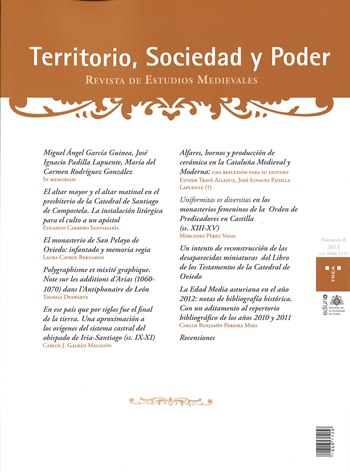Resumen
Resumen: A pesar de su reorganización barroca, la capillamayor de la catedral de Santiago de Compostela tiene unnotable número de noticias documentales, arqueológicas eimágenes históricas que permiten restituir su aspecto durantela Edad Media. De hecho, era un interesante conjunto enel que, en el extremo más oriental, se ubicaba el altar deprima en el que se celebraban las misas para los peregrinosy frente a éste, abierto al transepto de la catedral, el altarmayor dispuesto sobre el sepulcro apostólico y que recibíael culto de los peregrinos. Buena parte de los problemas quela historiografía contemporánea ha planteado sobre estadisposición topográfica se encuentran en la errónea lecturade su funcionamiento litúrgico desde unas coordenadasestilísticas histórico-artísticas, que han llevado a relacionar suinstalación litúrgica con la de San Pedro del Vaticano y otrasiglesias romanas. Si esta relación de dependencia con Romaparecía ser lógica a partir de los vínculos que el arzobispadocompostelano estableció con la Santa Sede desde finales delsiglo XI, por el contrario, éstos no tuvieron que ver con laorganización de la capilla mayor compostelana. De hecho,ésta responde a un planteamiento común con el resto dela arquitectura religiosa de Europa, organizanda en tornoa dos altares, el mayor y el matinal, en el que se realizabanlas misas de prima para laicos y el altar relicario del ApóstolSantiago.Palabras clave: Catedral. Santiago de Compostela. Altarmatinal. Altar de prima. Altar mayor. Topografía sagradaAbstract: (The hight altar and the matins altar in thepresbitery of the cathedral of Santiago de Compostela. Theliturgical installation for the worship to an apostle).Despite its baroque reorganization the presbitery of thecathedral of Santiago de Compostela has a remarkablenumber of documentary evidences, archaeological data andhistorical images that allow us to restore its appearanceduring the Middle Ages. In fact, the main chapel wasan interesting group in which, in its eastern end, stoodthe morning altar where they celebrated the MorningMasses for pilgrims and facing it, open to the transept ofthe cathedral, there was the high altar disposed over theapostolic tomb, that recieved the cult and the visits of thepilgrims. This sacred topography is described by the firsttime in the Codex Calixtinus, and though across sourcesthat include a chronological frame between the XIIth andXVIth century more important aspects can be specifiedon his architectural image. Nevertheless, many of theproblems that contemporary historiography has raised overthis topographical arrangement are in the wrong reading ofthis liturgical installation from stylistic historical-artisticcoordinates, which have led to connect the Jacobeaninstallation with that of St. Peter’s Basilica and other Romanchurches. Anyhow, from the most radical positions in thisrespect, there has been smoothed the reality of the confessioof the cathedral raised first as a crypt and later as a openspace behind the high altar and several meters below its level,always with Roman models as element of comparison. Thisrelations of dependence with Rome seemed to be logical dueto the links that the archdiocese Compostela established withthe Holy See from the late eleventh century. However, thispolitical relationship did not have to do with the liturgicalorganization of the main chapel of Santiago. In fact, the highaltar topography reflects a common approach with the restof the religious architecture of Europe, organized aroundtwo altars, the matins altar, where the morning masses tookplace for the laity and the main altar, the altar reliquary ofSt. James. Thus, by means of the liturgical explanation ofthis type of altars, in this article there is argued the absolutenormality of the matins altar of the cathedral in relation toits European context, and is underlined how the archaeologyindicates that its level of soil was the same that that of therest of the cathedral. This way, the architectural relationshipof the sacred topography of the presbytery of the cathedral ofSantiago with solutions that could resemble some churches ofRome is only a product of the contemporary historiography,from the monsignor Jose Guerra Campos’ works, realizedin the orbit of the studies on Christian archaeology of thepontifical academies.Keywords: Cathedral. Saint James of Compostela. MatinsAltar. High Altar. Morning Masses. Sacred Topography.Descargas
Los datos de descargas todavía no están disponibles.

